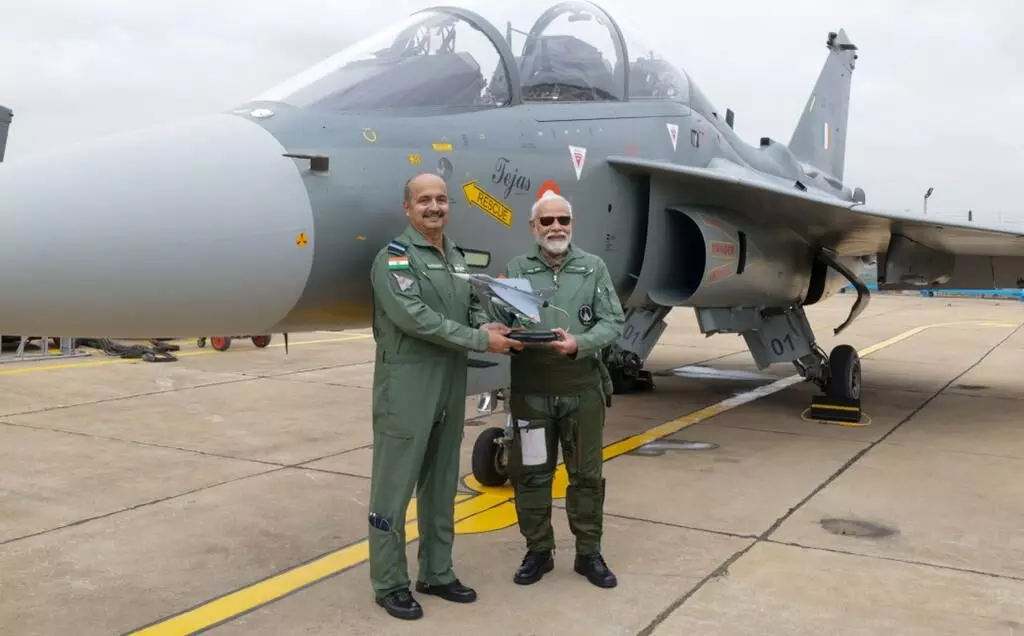Rewind 2023: 2023 saw India’s defence sector making the right noises with its strategic moves
Defence exports soared to a record `16,000 crore, thereby reducing dependence on military imports
image for illustrative purpose

Indian military spent 2023 looking for ways to refill its weapon stockpiles, preparing for future conflicts and pushing for a solid defence manufacturing ecosystem with a global outreach perspective
As we bid farewell to 2023, India's defence sector emerges as a dynamic force, signalling a paradigm shift in its approach towards national security. Throughout the year, the country’s military embarked on a mission to fortify its arsenal, proactively plan for future conflicts and establish a robust defence manufacturing ecosystem.
In a ground-breaking move, the Ministry of Defence committed itself to procure over Rs. 3.50 lakh crore worth of predominantly indigenously manufactured weapons and defence equipment. It marked a historic milestone as the domestic defence production surpassed the Rs. one lakh crore mark for the first time. Concurrently, defence exports soared to an unprecedented Rs. 16,000 crore, showcasing a remarkable tenfold increase since 2016-17 and a strategic move to reduce dependence on military imports.
The global stage witnessed a surging demand for India's indigenous defence products, with Made-in-India fighter jets - LCA Tejas, LCH helicopters, missile systems like BrahMos and Akash, Pinaka rockets and launchers, radars and artillery guns gaining international acclaim. Remarkably, India expanded its export footprint to over 85 countries, exemplifying the prowess of its defence industry, with 100 firms actively engaged in exporting defence products.
Hindustan Aeronautics Ltd (HAL) reported significant international interest, particularly from the Philippines, Egypt, Nigeria and Argentina, in acquiring the Tejas Light Combat Aircraft (LCA). The Tejas, a single-engine, multi-role fighter aircraft designed to operate in high-threat air environments, is configured for air defence, maritime reconnaissance and strike missions. Positioned to serve as the cornerstone of the Indian Air Force (IAF), the Tejas has already seen the induction of nearly 40 initial variant aircraft. Apart from the ongoing production of 83 Tejas MK-1A jets for the IAF, with deliveries slated to commence in February-March, the Defence Ministry has recently granted approval for an additional batch of 97 Tejas jets for the IAF.
Alongside the production of LCA Tejas jets, HAL is actively engaged in manufacturing 156 LCH Prachand helicopters and undertaking the modernisation of 84 Sukhoi Su-30 MKI jets.
The acquisition of this equipment will not only bolster the strength of the Indian Air Force (IAF) significantly but also elevate indigenous capabilities to unprecedented levels.
The nation has achieved self-reliance in a spectrum of defence technologies, including radars, torpedoes, electronic warfare systems, AWACS, gun systems, armoured vehicles, and Light Combat Aircraft. Moreover, sourcing from domestic defence industries will play a pivotal role in substantially diminishing dependence on foreign Original Equipment Manufacturers (OEMs).
Besides mastering LCA fighters, India is now a missile power. Its journey from surface-to-surface missiles like Agni, Prithvi, Dhanush, and Akash to air-to-air missiles Astra and further into surface-to-air longer and medium-range missiles has been nothing short of remarkable. The successful development of anti-tank missile Nag, helicopter-launched Helina, and the ballistic missile defence program's Pralay surface-to-surface missile has solidified India's status as a formidable missile power. Also, India has developed a range of naval missiles, including the BrahMos version, short-range SRSAM missiles, anti-ship missiles and air-to-ground missiles.
Refilling weapon stockpiles: The year was marked by the government's strategic decisions in procuring Light Combat Helicopters, Light Combat Aircraft Mk 1A, Medium-Range Anti-Ship Missiles, and the Towed Gun System. Notably, the acquisition of 26 Rafale Marine aircraft from France, 31 MQ-9B High Altitude Long Endurance Remotely Piloted Aircraft Systems from the United States, BrahMos missiles for the Indian Navy, and Long Range Stand-Off Weapon for the Indian Air Force, which will be integrated into SU-30 MKI aircraft further enhanced defence capabilities.
The country’s expanding indigenous defence capabilities have not only strengthened its national security but have also opened avenues for collaboration and export opportunities.
Air Chief Marshal V.R. Chaudhari highlighted the competitive and dependable choices provided by LCA, LCH and Akash platforms to air forces globally, particularly in the global south. Advocating for joint ventures, co-development, and regional support hubs, Chaudhari emphasised the need for India to concentrate on global supply chains, manufacturing hubs, and setting up maintenance and support facilities.
As we reflect on the year gone by, India's defence sector stands poised at the intersection of innovation, self-reliance, and global collaboration, setting the stage for a more secure and technologically advanced future.
(The writer is a journalist who writes on defence, strategic affairs and technology)

